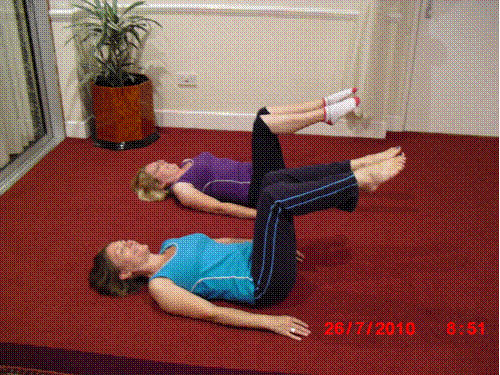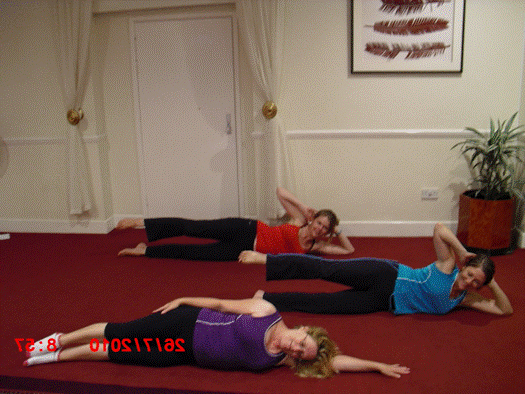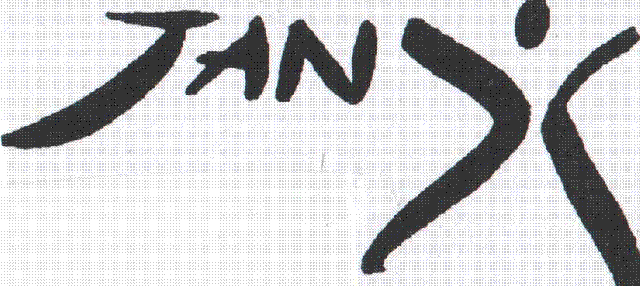Pilates
To see class times and venues click here.
Pilate classes run on a six week course basis.
Hi Welcome to my Pilates page.
I have been teaching pilates for about 10 years now. It has been a wonderful journey for my own body. Having always done Aerobics, it took time for my body to slow down and be more precise about the exercise I was doing. I love Pilates, I feel stronger and more flexible than I have ever felt and would like everyone to learn how to do it!
It does take time, especially if you have never worked with your ‘core’ before, but with patience and practice the rewards are worth it.
I teach group classes and also do one to one. I advise people to have a one to one session first, if they have any specific health issues. ( Sometimes a beginners class is not available at a convenient time or venue.)
History
What is Pilates
Why Pilates
The Eight Principles of the Pilates Technique
Benefits






History
Pilates was the brain child of Joseph Pilates born in 1880, near Dusseldorf, Germany. Throughout his childhood he suffered a range of debilating conditions, including rickets, asthmas and rheumatic fever. He was determined to overcome his poor physical health and devoted his time to the task of becoming fit and strong. He went on to study numerous sports and fitness activities. At the age of 14 he was in such good shape, that he was able to work as a model on anatomy charts!!
It was when Joseph Pilates was interned during World War One, because of his nationality, that ‘Pilates’ started to be born. He naturally fell into the role of being a physician to his inmates. He devised fitness equipment from bed springs, so that his patients could exercise while lying down.
Joseph Pilates went on to develop ‘Pilates’ further, opening up studios and helping dancers to become stronger. He died in 1967, leaving behind a legacy, which even today is still growing and improving.
Thank you Joseph Pilates for this wonderful form of fitness.
What is Pilates
Pilates is not just a set of exercises you do - it is the quality and control over the movement that is important. It becomes a way of life - enriching your day to day activities.
Why Pilates
Because it strengthens and streamlines your body - giving you a sense of well-being, enabling you to relax and ultimately lead a healthier lifestyle.
Pilates looks very similar to Yoga and has Yoga in it. Joseph was influenced by various physical disciplines, Yoga being just one of them. The difference is the breathing. As we want to flatten our tummies, we hold it in and breath laterally.
We keep the pelvis in neutral ( half way position of the lower back ). Then we zip up. (Pulling up an imaginary zip and doing up an imaginary belt across the naval.) The ‘core’ is pulling in the navel in about 30% or pulling up the pelvic floor muscles.
The Eight Principles of the Pilates Technique.
1.Concentration
With many exercise techniques and programmes you can switch off while participating in the exercise, with Pilates based exercises every moment is a thought process and every movement is controlled by thought. The “mind body” side of this technique is that you block out other thoughts while focussing on movement.
2.Breathing
Breathing is a huge part of this technique, but as you will find, the hardest to perfect and yet the most important to be perfected. The main rule to remember is that you breath out on the greatest effort. The abdominal muscles are contracted and you breathe out sideways. Try this test:
In a standing position, place your hands on your elbows, extend to the side while pulling the abdominal muscles up.
3. Centering
With the huge movement in the fitness industry towards functional exercise programs, the torso and back are areas that require major attention. We spend most of the day sitting at work so exercises that improve the way we sit are exercises we require daily. So to sit correctly we need to concentrate on balancing and centring the torso area.
In pilates based exercises your centre is your “Power House” and your core strength. Every exercise is controlled by the contraction of you abdominal muscles. The body is working as a unit.
4.Control
Working against gravity with Pilates based exercises strengthens your body. The slower the movement the greater the strength we gain.
5.Precision
To place the body in a certain exact position at the beginning is difficult, but routine in the technique leads to control of the movement and therefore exact execution of exercise.
6. Flowing Movements
Pilates based exercises are a continuous movement, as in a wheel turning continuously with the same speed throughout the cycle and range of movement.
7.Isolation
The Pilates based exercises challenge each person differently as with different body types and with different training programmes, and we all have different strengths and weaknesses. The educational side of the technique is that through the balancing effects of the technique we begin to learn our body’s structure, and therefore the control of different muscle groups lets us isolate.
8.Routine
As with any principle, repetition and frequency leads to the skill level rising. The technique is not meant to be a replacement for any other activity but an addition, to strengthen your body for whatever activity you need it for.
With patience and practice you will see results.
Benefits
. Posture improvement
. Flattens and strengthens your stomach
. Strengthens your back muscles
. Improves flexibility
. Improves joint mobility
. Improves balance and co-ordination
. Improves muscle length and strength
. Helps with sport injury recovery
. Releases tension
. Helps with concentration and balance
To see class times and venues click here